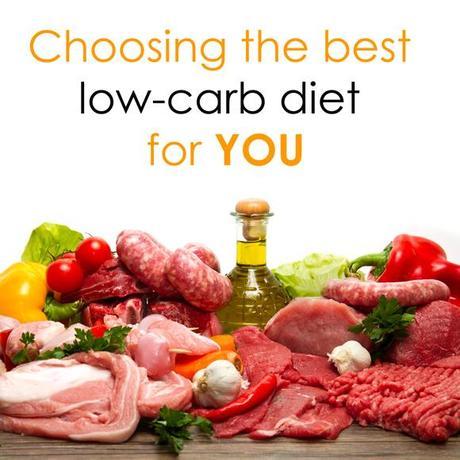 “Which low-carb diet is the best one?” is the perennial question I get asked time and again. My answer is always the same – there is no such thing as the best diet overall.
“Which low-carb diet is the best one?” is the perennial question I get asked time and again. My answer is always the same – there is no such thing as the best diet overall.
We are all different – there is no single solution that would be suitable for everyone.
This post outlines some points to consider when choosing a low-carb diet plan that’s right for you.
Quick introduction to low-carb diets
Broadly speaking, low-carb diets restrict the amount of carbohydrates you consume to create calorie deficit and encourage fat burning. Examples of foods high in carbs are grains (e.g. rice, bread, pasta), anything with refined sugar (e.g. sweets, non-diet fizzy drinks), and also some starchy vegetables such as potatoes. Diets that are very low in carbs can result in ketosis – a natural state where body burns fat for fuel instead of carbohydrates.
Going low-carb means cutting out (or at least, dramatically reducing) your consumption of such foods. Standard Western diets usually include quite a lot of high-carb foods, so low-carb usually means a major lifestyle change. Although it would require effort and determination, weight loss and health benefits of going low-carb can be significant. Read more about the basics of low-carb dieting…
Snapshot overview of popular low-carb diet plans
I have put together a brief overview of five popular low-carb diet plans, across a range of criteria to help you choose the most suitable one. The following plans have been included:
- Atkins: the original and still the best-known low-carb diet, consisting of 4 phases, starting with Induction at just 20g net carbs a day and gradually increasing. More about Atkins Diet…
- Dukan: very low-fat as well as low-carb and quite radical, starts with Attack phase of several days on protein-only foods, followed by protein-only days alternating with days on protein plus salad vegetables. More about Dukan Diet…
- Keto: similar to Atkins Induction, daily carbs are kept to a minimum throughout the full duration of the diet. More about Keto Diet…
- Paleo: although not specifically designed to be low-carb, Paleo excludes foods made available by agriculture and processed foods, cutting out grains and refined sugar, which results in lower carb consumption. More about Paleo Diet…
- South Beach: low-fat as well as low-carb but a lot less radical than Dukan, with several phases. More about South Beach Diet…
Click on the diet’s name in the first row to see its overview and pros/cons, and click on the criteria in column one to see the full explanation below.
Atkins Dukan Paleo Keto South Beach
1. Weight loss guaranteed1, 2 Yes Yes No Yes No
2. Easy to follow2 No No Yes No Yes
3. Phased structure Yes Yes No No Yes
4. Amount of fat High Very low High High Low
5. Ketogenic Yes No No Yes No
6. Suitable for intensive exercise2 Yes No Yes Yes Yes
7. Requires carb counting Yes No No Yes No
8. Sweeteners allowed Yes Yes No Yes Yes
9. Easy for vegetarians2 No No No No Yes
10. Supplementation2 Yes Yes Optional Yes Optional
1 provided all the guidelines of the diet are followed fully and accurately
2 these criteria are subjective and a matter of opinion rather than fact. I provided my judgment based on my knowledge and experience, but other people may have different opinions (please feel free to share in the comments below)
1. Weight loss guaranteed / 2. Ease of following the diet
These first two factors are linked as a trade-off – stricter diets would enable faster weight loss BUT also require more effort and willpower, and you would be more likely to give up the diet. In either case, it is important to have realistic expectations and not expect miracles overnight.
Where weight loss is mentioned as guaranteed, this is only the case if you definitely stick with all the guidelines of the diet.
If you keep attempting strict diets and falling off the wagon after several days or weeks, I would recommend choosing a more moderate plan. It’s better to lose weight slowly and gradually than not at all! Read more on weight loss success tips…
3. Low-carb diets with phased structure
Some low-carb diets plans start out with a short strict phase (often ketogenic), designed to reset your metabolism and food habits, and then gradually move to longer but less restrictive stages. Phased structure is good if you are a beginner or if you can’t (or don’t want to) cope with restrictions for too long.
4. Amount of fat on a low-carb diet
Many low-carb diets are very high in fat (basically replacing your energy source from carbs to fat), whereas some other plans are also low-fat (most notably Dukan). It is difficult to get into ketosis if you don’t consume extra fat with your diet, and overall low-carb low-fat diets are much harder to stick to than low-carb high-fat (LCHF, e.g. Atkins Induction or Keto).
Health benefits of fat consumption. Although new research shows dietary fat is not quite the devil it was once thought to be (and in fact could have substantial health benefits), some people are still afraid of it, and so prefer to keep their fat intake low or moderate. Both low-fat and high-fat camps are passionate about their beliefs and have research to back them up, so you would have to make up your own mind about this aspect. (Personally, I believe that LCHF is the most effective and healthy way, but this is based on my own experiences and can’t be extrapolated on to everyone.)
5. Ketogenic low-carb diets
Ketosis is a natural state when your body starts converting fat for fuel instead of glucose. This occurs when carbohydrates are reduced to a minimum for a period of time, usually less than 20g net carbs a day for at least 5-7 days (e.g. Keto, Atkins Induction). Ketosis (not to be confused with ketoacidosis) is not unhealthy, and there are people who stay in ketosis for months and even years.
Getting into ketosis can be difficult – for the first several days, you might experience fatigue, headaches and general lack of energy. However, once ketosis kicks in, these symptoms disappear and you are likely to have more energy than before. Hunger and sugar cravings will go away, and you can achieve fast weight loss in this state. You will need to keep your carb intake to a minimum in order to stay there – eat something high in carbs and you will get knocked out and back to square one.
If you keep trying to get into ketosis but can’t cope with the initial symptoms, or if you keep getting knocked out after several days, then reconsider your plan and pick a diet that’s not ketogenic (e.g. South Beach).
6. Diets suitable for intensive exercise
If you are an athlete, or if you do regular high-intensity exercise such as weight lifting, bodybuilding or sprint running, your dietary needs will obviously be very different to those of sedentary people. This is really a specialist area but generally speaking, the two low-carb diets that are popular with this group of people are variations of Keto (CKD / TKD), and Paleo.
If your lifestyle is mostly sedentary, and your exercise levels are small or moderate, you don’t need to worry too much about the diet’s implication on your performance. All popular low-carb diet books usually include guidance and advice on exercising during that particular diet.
7. Low-carb diets that require carb counting
Some low-carb diets require counting of all net carbs consumed. This can seem laborious at first, but you get used to it quickly. There are special food tracking apps and tools available to help you. Keeping a food diary is actually supposed to be beneficial overall anyway – you are less likely to deviate from your diet if you have to make a note of everything you eat.
If you find the idea of food tracking a bit of a nightmare, opt for a plan that doesn’t include it. Typically, such plans will provide a list of permitted or banned foods and leave it at that.
8. Sweeteners and processed foods allowed on low-carb diets
Some diets (mainly Paleo/Primal plans) exclude all refined and processed foods, including artificial sweeteners.
Interestingly, Dr Atkins allowed sweeteners in moderation, but since his death Atkins Nutritionals corporation seem to disregard it all, and churn out masses of artificially sweetened Atkins bars, milkshakes, even breakfast cereals. Please stick with the advice given in the original book and avoid these products if you can. If you must have something sweet, make a low-carb dessert from scratch – at least you will know exactly what’s in it. Read more about sweeteners on a low-carb diet…
9. Low-carb diets for vegetarians
Apologies to vegetarians, but low-carb is extremely tricky to adapt to your lifestyle. It relies on protein and restricts consumption of grains, root vegetables and fruit, which all play a big role in vegetarian diets. The most well-known plan to have a specific vegetarian version is South Beach for Vegetarians.
10. Supplementation required on low-carb diets
Guidelines vary from diet to diet, but generally, dietitians do recommend taking supplements to support low-carb diets, especially during the really restrictive stages. Dr Atkins had some very specific recommendations with regards to Atkins Diet supplements. Some targeted low-carb diet supplements are available from our low-carb shop.
Final word of caution
Whatever you do, please always stick with well-known diet plans that have been tried and tested, and never resort to desperate measures that promise overnight results, such as diet pills – that’s just plain stupid and likely to damage your health.
Always consult your GP or another qualified medical practitioner before starting a new diet, if any of the following apply:
- you have a medical condition or are under medical supervision for any reason
- you are pregnant or breastfeeding
- your BMI is over 30
- you would like to lose over 25% of your current weight
- you are under 18 or over 60 years old
- you have any other concerns or questions about weight loss in general or low carb dieting in particular

Posted on 27 December 2013 by Carbophobic. Diet tips and aids, Motivation

